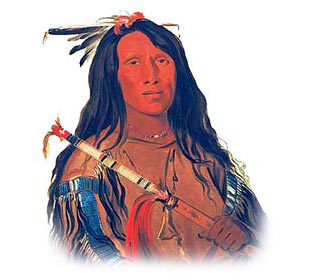Description of Talking Sticks
The people responsible for holding any type council meetings were required to make a Talking Stick specifically for the event. Talking sticks were therefore made from carefully selected materials that had a special meaning and significance to the maker. The size of Talking sticks was usually taken from the measurement between the elbow to the tips of the fingers. Talking Sticks were usually long, narrow, brightly colored and adorned with furs and or feathers. Symbolism associated with Talking Sticks
Talking Sticks are decorated with paint, carvings and occasionally wrapped in buckskin or other leather materials. The ornamentation, colors and painted decorations on talking sticks had special meanings, as did the wood they were made from and any fur or feathers that were used. The symbolism associated with the fur, skins, feathers or symbols of animals used in the decoration of talking sticks were also highly significant due to the belief that they brought the attributes, characteristics and medicine of the creatures to the event. Talking Sticks Symbolism - Colors
The symbolism associated with the colors used to paint and decorate Talking Sticks was fundamental to the success of the event bring specific medicine to the proceedings. The colors were carefully chosen and the following chart provides details of the symbolism of the colors used to decorate and paint talking sticks. - Blue: Intuition, Prayer, Wisdom
- Black: Clarity, focus, success and victory
- Red: Life, Faith and Happiness
- White: Sharing, Purity, Spirit and Light
- Yellow: Knowledge and courage
- Orange: Kinship, Intellect and Determination
- Green: Nature, Harmony and Healing
- Purple: Power, mystery and magic
Talking Sticks Symbolism - Animals
The symbolism associated with the skins, strands of hair or fur and the feathers used to embellish Talking Sticks were also significant. The animals were carefully chosen reflect as they are believed to represent the physical form of a spirit helper and guide. The following chart provides details of the symbolism of some of the animals used to adorn talking sticks and the characteristics and attributes it might give to the event. - Bear: Courage, physical strength and leadership
- Beaver: Determination and strong-will
- BuffaloStrength, abundance and gratitude
- Deer: Gentleness, grace and survival
- Fox: Anticipation, observation and stealth
- Horse: Mobility, stamina, strength and power
- Raccoon: Curiosity, adaptability and resourcefulness
- Porcupine: Innocence, companionship, and trust
- Prairie Dog: Swiftness and preparedness
- Squirrel: Planning and home life
- Wolf: Direction and leadership
Talking Sticks Symbolism - Feathers
The type of feathers attached to Talking Sticks also hold significance and symbolism. An Eagle Feather represents truth and high ideals, the turkey feather is used to bring peaceful attitudes especially in disputes. The owl feather is deemed to be powerful and prevents deception from entering the Sacred Space of the Council. Talking Sticks Symbolism - Types of Trees and wood
The symbolism associated with the types of wood used to make Talking Sticks was also important. The wood was carefully chosen for its qualities, attributes, strength and spirituality and taken from a tree that had special meaning to the person. Permission was sought from the tree spirit to make the talking stick. The following chart provides details of the symbolism of the trees used to make talking sticks. - Birch: Truth, new beginnings and cleansing of the past
- Cedar: Cleansing, protection, prosperity & healing
- Willow: Wisdom, an open mind, strength of age and experience.
- Walnut:Clarity and focus, beginning new projects
- Oak: Strength of character and courage
- Cherry: Strong expression, rebirth, new awakenings and compassion
- Pine: Creativity, peace and harmony
- Ash: Peace of mind, sacrifice, sensitivity and higher awareness
- Maple: The tree of offering, generosity, balance and practicality
- Arbutus: Knowledge
- White Pine: Serenity
- Sycamore: Ambition
- Aspen: Clarity of purpose, determination and overcoming doubts
- Elm: Wisdom, strength of will and intuition
- Beech: Tolerance, past knowledge and softens criticism
Talking Sticks
There were rules and codes of conduct which surrounded the use of Talking Sticks which made them incredibly useful. Talking sticks provided the way to hold an orderly, just and impartial meeting - even with enemies. Talking sticks were commonly used in council circles to designate who had the right to speak. When matters of great concern came before the council, the leading elder would hold the talking stick and begin the discussion. The rules and protocol followed when using Talking Sticks are as follows: - The elder speaks first
- No-one is allowed to interrupt and everyone must listen to what is being said
- When the elder has finished speaking the Talking Stick is handed to the next person in the circle
- If the receiver chooses not to speak the Talking Stick is passed to the next person in the circle
- The stick is passed from one individual to another until all who wished to speak had done so
- The talking stick is then passed back to the leading elder for safe keeping
The use of talking sticks allows everyone to express their sacred point of view. |
